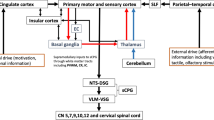Abstract
As the work of Dr. Martin Donner has brought a clarity to understanding swallowing, so has the work of various neuroscientists, including that of a Nobel Laureate, in providing us with a better comprehension of this complex motor pattern. Understanding the neural control of swallowing has been a process that has occurred during this century in which several investigators, primarily from Europe, Japan, Canada, and the United States, have brought their perspectives in applying particular techniques to decipher how the central and peripheral nervous system control swallowing. Swallowing represents a complex muscular response of the oral, pharyngeal, and esophageal regions which are integrated to provide an effective functional pattern that prepares and transports food while simultaneously protecting the airway. This adaptation of the upper gastrointestinal tract in mammals has been extensively studied peripherally by two methods: recording from the peripheral nerves and muscles, and stimulating peripheral nerves and their receptive fields that can induce the pharyngeal and esophageal phases of swallowing. The study of the peripheral nervous system has provided insight into the sensory receptive fields that evoke or facilitate swallowing, and has established the first serious evidence of the all-or-none sequential contraction pattern of the oropharyngeal and esophageal muscles. It has been these electromyographic studies of the muscles that has established much of the criteria for evaluating the central swallowing pathway. Five techniques have been applied to the central nervous system to study swallowing and include lesioning or destroying discrete regions to determine how swallowing is impaired or modified, electrically stimulating the central neural tissue to determine the type of effects on swallowing, recording from the central neural tissue with macro- and microelectrodes to ascertain when neurons respond in timing to the peripheral muscle activity during swallowing, applying pharmacological agents through micropipettes which could mimic or inhibit potential transmitters, and using immunochemical techniques to tag specific chemicals that could be transmitters used by the neurons in the central swallowing pathway. These various techniques have provided insight into how the central swallowing pathway is organized but the details of the central control are still in the process of being defined and will require as much effort this next century as has been previously developed over the past 90 years.
Similar content being viewed by others
References
Miller FR, Sherrington CS: Some observations on the buccopharyngeal stage of reflex deglutition in the cat.Q J Exp Physiol 9:147–186, 1916
Doty RW, Bosma JF: An electromyographic analysis of reflex deglutition.J Neurophysiol 19:44–60, 1956
Kawasaki M, Ogura JH, Takenouchi S: Neurophysiologic observations of normal deglutition. I. Its relationship to the respiratory cycle.Laryngoscope 74:1747–1765, 1965
Doty RW: Influence of stimulus pattern on reflex deglutition.Am J Physiol 166:142–158, 1951
Doty RW: Neural organization of deglutition. In: Code C (ed.):Handbook of Physiology. Alimentary Canal, Section 6, Vol 4. Washington DC: American Physiological Society, 1968, pp 1861–1902
Doty RW, Richmond WH, Storey AT: Effect of medullary lesions on coordination of deglutition.Exp Neurol 17:91–106, 1967
Jean A: Localisation et activite des neurones deglutiteurs bulbaires.J Physiol (Paris) 64:227–268, 1972
Kessler JP, Jean A: Identification of the medullary swallowing regions in the rat.Exp Brain Res 57:256–263, 1985
Jean A. Puizillout JJ:Neurobiology of the Nucleus of the Solitary Tract. International Satellite Symposium of the 10th Annual Meeting of the European Neuroscience Association. Marseille, France, September 14, 1986
Jean A: Brainstem control of swallowing: localization and organization of the central pattern generator for swallowing. In: Taylor A (ed.):Neurophysiology of the Jaws and Teeth. London: MacMillan Press, 1990
Sessle BJ, Henry JL: Neural mechanisms of swallowing: neurophysiological and neurochemical studies on brain stem neurons in the solitary tract region.Dysphagia 4:61–75, 1989
Bieger D: Neuropharmacologic correlates of deglutition: lessons from fictive swallowing.Dysphagia 6:147–164, 1991
Kessler JP, Jean A: Inhibition of the swallowing reflex by local application of serotonergic agents into the nucleus of the solitary tract.Eur J Pharmacol 118:77–85, 1985
Kessler JP, Jean A: Effect of catecholamines on the swallowing reflex after pressure microinjections into the lateral solitary complex of the medulla oblongata.Brain Res 386:69–77, 1986
Cherkaoui N, Jean A, Kessler JP: Activation of excitatory amino acid receptors within the nucleus tractus solitarius elicits the swallowing motor pattern in the anesthetized rat.J Physiol (London) 407:16P, 1988
Hashim MA, Bieger D: Excitatory amino acid receptor-mediated activation of solitarial deglutitive loci.Neuropharmacology 28:913–921, 1989
Jean A, Amri M, Calas A: Connections between the ventral medullary swallowing area and the trigeminal motor nucleus of the sheep studied by tracing techniques.J Auton Nerv Syst 7:87–96, 1983
Cunningham ET, Sawchenko PE: Central neural control of esophageal motility: a review.Dysphagia 5:35–51, 1990
Kalia M, Fuxe K, Hokfelt T, Johansson O, Lang R, Ganten D, Cuello C, Terenius L: Distribution of neuropeptide immunoreactive nerve terminals within the subnuclei of the nucleus of the tractus solitarius of the rat.J Comp Neural 222:409–444, 1984
Schaffar N, Kessler JP, Bosler O, Jean A: Central serotonergic projections to the nucleus tractus solitarii: evidence from a double labeling study in the rat.Neuroscience 26:951–958, 1988
Ricardo JA, Polak JM, Fernandes MA, Ghatei P, Mulderry P, Bloom SR: Calcitonin gene-related peptide immunoreactive sensory and motor nerves of the rat, cat, and monkey esophagus.Gastroenterology 88:444–451, 1985
Cunningham ET, Benoit R, Sawchenko PE: A circumscribed project from the nucleus of the solitary tract to the nucleus ambigous in the rat: anatomical evidence for somatostatin-28 immunoreactive interneurons subserving reflex control of esophageal motility.J Neurosci 9:1668–1682, 1989
Hashim MA, Bieger D: Excitatory action of 5-HT on deglutitive substrates in the rat solitary complex.Brain Res Bull 18:355–363, 1987
Tell F, Fagni L, Jean A: Neurons of the nucleus tractus solitarius, in vitro, generate bursting activities by solitary tract stimulation.Exp Brain Res 79:436–440, 1990
Author information
Authors and Affiliations
Rights and permissions
About this article
Cite this article
Miller, A.J. The search for the central swallowing pathway: The quest for clarity. Dysphagia 8, 185–194 (1993). https://doi.org/10.1007/BF01354537
Issue Date:
DOI: https://doi.org/10.1007/BF01354537



